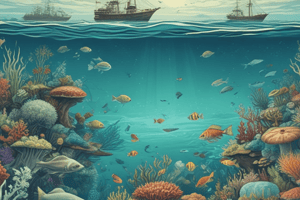Podcast
Questions and Answers
What is the definition of Temperature in relation to ocean abiotic factors?
What is the definition of Temperature in relation to ocean abiotic factors?
- A measure of salinity.
- How organisms reproduce.
- A measure of the heat intensity. (correct)
- A measure of fitness among organisms.
What does salinity measure?
What does salinity measure?
How salty water is.
What are nutrients essential for?
What are nutrients essential for?
Growth and maintenance of life.
What is sediment?
What is sediment?
Why is oxygen important in ocean ecosystems?
Why is oxygen important in ocean ecosystems?
Solar energy is used by organisms to produce carbohydrates.
Solar energy is used by organisms to produce carbohydrates.
How does water clarity affect marine life?
How does water clarity affect marine life?
What causes tides in the ocean?
What causes tides in the ocean?
What causes waves in the ocean?
What causes waves in the ocean?
What is substrate in the ocean?
What is substrate in the ocean?
What is aerial exposure?
What is aerial exposure?
What are ocean currents?
What are ocean currents?
Study Notes
Ocean Abiotic Factors
-
Temperature
- Influences organism habitats, reproduction, migration patterns, and food availability.
-
Salinity
- Measures salt concentration in water; varies greatly in coastal areas due to tides.
- Organisms in such environments develop adaptations for changing salinity levels.
- Open ocean salinity remains relatively stable.
-
Nutrients
- Essential substances for growth and life maintenance; abundant in shallow temperate waters.
- Nutrient-rich waters are often brought to the surface by tidal movement from benthic sediments.
-
Sediment
- Comprises materials like sand and small rocks found on the ocean floor.
-
Oxygen
- Crucial for respiration, metabolism, photosynthesis, and other life-sustaining chemical processes.
-
Solar Energy
- Sunlight is harnessed by algae and phytoplankton through photosynthesis, supporting the marine food web.
-
Water Clarity
- Indicates light penetration through the water column; affected by dissolved and suspended particles.
- Shallow coastal areas typically have lower clarity; mangrove trees and seagrass improve clarity by filtering sediments.
-
Tides
- Result from gravitational forces of the Sun and Moon, significantly impacting coastal habitats.
- Tides bring about fluctuations in temperature, salinity, and oxygen levels.
-
Waves
- Energy-induced disturbances in ocean water primarily driven by wind.
- Most significantly affect coastal organisms.
-
Substrate
- The ocean bottom consists of diverse materials like rock, sediment, coral reefs, and artificial items like shipwrecks.
- Substrate type influences local ecosystems and species distribution.
-
Aerial Exposure
- Refers to the duration organisms interact with air; crucial for survival.
- Organisms along coastlines, such as mussels, often seek shaded areas to minimize exposure.
-
Currents
- Mass movements of ocean water, driven by wind, tides, and Earth's rotation.
- Currents interconnect different ocean regions, influencing species distribution and nutrient flow.
Studying That Suits You
Use AI to generate personalized quizzes and flashcards to suit your learning preferences.
Description
Explore key terms related to abiotic factors in ocean ecosystems with these flashcards. Learn about temperature and salinity, and how these elements affect marine life. Ideal for environmental science students looking to enhance their knowledge.




